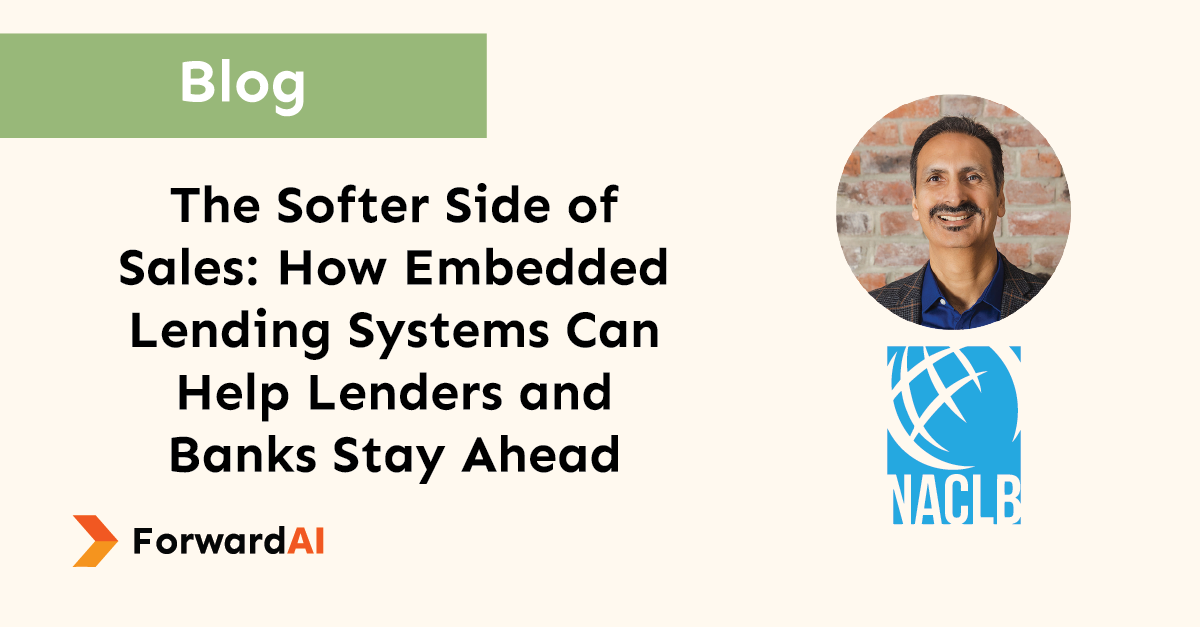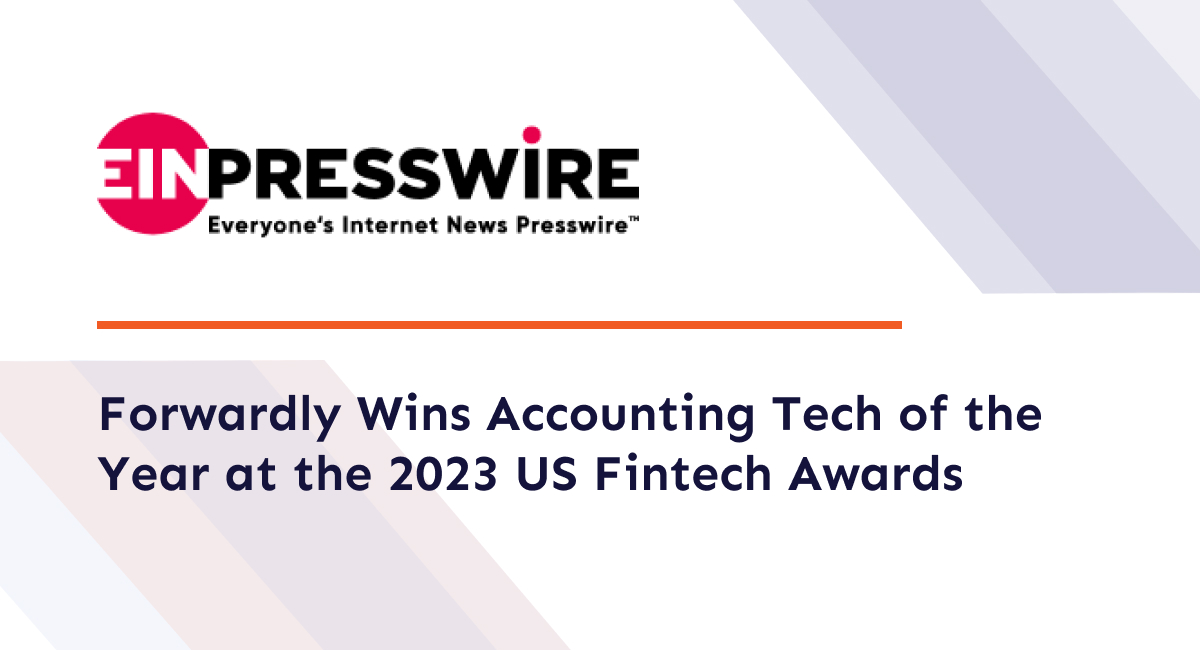The Softer Side of Sales: How Embedded Lending Systems Can Help Lenders and Banks Stay Ahead

Originally published on DealMaker Magazine.
By Nick Chandi, CEO and Co-Founder, ForwardAI
The unpredictable changes of the COVID-19 pandemic have thrust small and medium-sized businesses and lenders into a new reality, one that is mainly dependent on the latest technologies to continue functioning. DealMaker examines three ways embedded lending systems can help.
Digitization happened faster than most people anticipated due to the global COVID-19 pandemic, and most lenders weren’t ready for it. The good news is consumer-level technology adoption has always been quick. The bad news? The small business market has been left in the dark.
It’s almost like a recurring theme or a vicious loop – a global movement takes place and innovation starts in the business-to-consumer (B2C) market. Then, by the time the business-to-business (B2B) market tries to catch up, the B2C market has already moved on to the “next big thing.”
But it’s no surprise – complications due to complex processes, changing regulations and legacy technologies make it hard for B2B lenders to adapt quickly. Small and medium-sized business (SMB) lenders suffer even more when considering low-profit margins due to inefficient and unscalable underwriting or ineffective risk management. Compounded with a growing number of loan distributors such as fintechs, e-commerce or even accounting companies, it is truly a stressful time for SMB lenders.
However, that can change if SMB lenders move toward embedded lending to compete against loan originators who are already taking advantage of it. Here are the three reasons why embedded lending can help lenders and banks stay ahead of the game in an increasingly competitive market:
Lending in the SMB Space
SMBs might be seen as B2B customers, but they often exhibit consumer-esque behaviors and expectations. After all, SMB owners are consumers like everyone else after their business hours. They are used to the seamless customer experience in the consumer space and are starting to demand the same for their SMBs.
The reality is that SMBs are open to embedded finance and want to get all their financial services in one place. In fact, they want it so much that 47% of SMBs are willing to pay a price premium for a better experience from digital service providers.
The extent to which SMBs demand embedded financial services is astonishing and embedded lending is a crucial cornerstone. SMBs repeatedly cite cash flow as one of the factors for why they failed. Not all SMBs have excess cash to make the capital expenditures they need, and decisions are often made quickly and on a whim.
Lenders want to be visible when SMBs are browsing for financing options. What might not be a feasible purchase under normal circumstances can be seamlessly encouraged with embedded lending. Not only does it ensure a lender can create a frictionless lending experience, but embedded lending also pushes for incremental sales and lending opportunities that would have otherwise been left uncapitalized. It is a low-hanging fruit that could add a significant revenue stream for lenders, which leads us to the next point.
Lenders and Banks and Existing Relationships with SMB Customers
Compared to new-age loan originators such as software-as-a-service or e-commerce companies, banks and other financial institutions have a much longer relationship with their customers that they can leverage.
Customer trust and confidence are not easy to come by, especially when dealing with sensitive information or anything monetary. The choice becomes clear when the average borrower is faced with a dilemma between a new startup or a financial institution they have been banking with for years. In fact, banks expect ecosystem banking initiatives like embedded lending will reduce churn rate by up to 10% over the next three years. A service offered by a bank is much more likely to be adopted than an “untrustworthy” third-party vendor that might sell your data or scam you for existing clients.
Another big pro of embedded lending offered by banks to existing customers is easier risk management. Know-your-customer (KYC) practices have always been an essential aspect of credit underwriting, and SMB lending fraud has increased by 6.9% since 2020. Lending to existing customers can help banks reduce default rates efficiently, as they don’t need to invest additional resources to understand how likely it is that an existing customer might default on their loans.
With established customer confidence and effective risk management, no better markets can be monetized quicker than the added revenue stream from embedded lending.
Helping Banks Stand Out
If everything before this still isn’t convincing, here are some hard statistics: 43% of SMBs have increased their use of online banking services, 36% are likely to consider switching their main financial provider in the future and 48% would like to have received faster access to credit when needed.
Simply put, SMBs are hunting for better financial services and products in an integrated environment, and there’s no ground for standing still. Fintech and new-age lenders with modern technology stacks are enabled to meet new customer demand better. Traditional financial institutions have other advantages, but they are nowhere near enough to keep the customers around.
How can banks and lenders stay relevant? Embedded lending is one solution. If an SMB needs quick access to credit, convenience and speed become key. Expecting customers to choose to apply for credit over an embedded payment option is unrealistic at best.
There is no ground for financial institutions to stand still. With embedded lending, financial institutions have a leg up with an added value in their offerings against new-age competitors. It creates the customer-centric, streamlined experience that modern customers want, and people are more likely to engage banks due to brand trust. Plus, without it, financial institutions risk losing their customers to new-age competitors with better offerings.
SMBs Are Demanding More
With the popularization of digital channels and more new-age loan originators, SMB lenders must act now. Although most banks and lenders can’t adapt quickly due to numerous constraints, many organizations are turning to fintech to deliver more offerings to the market quickly.
Relying on fintech partners can help small business lenders incorporate new data signals to streamline the underwriting process. New data sources can also address risk management issues by assisting lenders in making more accurate decisions at scale.
The market size and profitability for embedded lending is well documented. It used to be that the B2B market always fell behind, but not anymore. With more fintechs explicitly built to partner with financial institutions, lenders can be pioneers in satisfying customer demands.
Embedded lending can unlock new revenue streams and provide access to capital for SMBs marginalized from the traditional credit model. SMBs make up the backbone of our economy, and embedded lending can propel the economy forward in ways we cannot even imagine yet.
Originally published on DealMaker Magazine.


